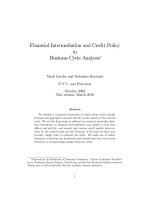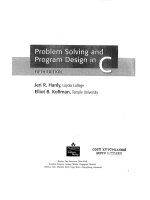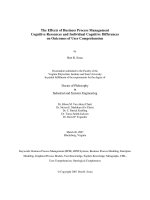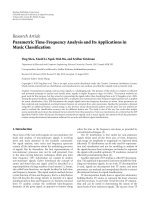dataflow analysis and workflow design in business process management
Bạn đang xem bản rút gọn của tài liệu. Xem và tải ngay bản đầy đủ của tài liệu tại đây (868.21 KB, 139 trang )
DATAFLOW ANALYSIS AND WORKFLOW DESIGN IN BUSINESS
PROCESS MANAGEMENT
by
Sherry Xiaoyun Sun
__________________________
Copyright © Sherry Xiaoyun Sun 2007
A Dissertation Submitted to the Faculty of the
COMMITTEE ON BUSINESS ADMINISTRATION
In Partial Fulfillment of the Requirements
For the Degree of
DOCTOR OF PHILOSOPHY
WITH A MAJOR IN MANAGEMENT
In the Graduate College
THE UNIVERSITY OF ARIZONA
2007
UMI Number: 3257364
3257364
2007
UMI Microform
Copyright
All rights reserved. This microform edition is protected against
unauthorized copying under Title 17, United States Code.
ProQuest Information and Learning Company
300 North Zeeb Road
P.O. Box 1346
Ann Arbor, MI 48106-1346
by ProQuest Information and Learning Company.
2
THE UNIVERSITY OF ARIZONA
GRADUATE COLLEGE
As members of the Dissertation Committee, we certify that we have read the dissertation
prepared by Sherry Xiaoyun Sun
entitled Dataflow Analysis and Workflow Design in Business Process Management
and recommend that it be accepted as fulfilling the dissertation requirement for the
Degree of Doctor of Philosophy
_______________________________________________________________________
Date: 4/19/2007
J. Leon Zhao
_______________________________________________________________________ Date: 4/19/2007
Jay F. Nunamaker, Jr.
_______________________________________________________________________ Date: 4/19/2007
Daniel Zeng
_______________________________________________________________________ Date: 4/19/2007
Martin Frické
Final approval and acceptance of this dissertation is contingent upon the candidate’s
submission of the final copies of the dissertation to the Graduate College.
I hereby certify that I have read this dissertation prepared under my direction and
recommend that it be accepted as fulfilling the dissertation requirement.
________________________________________________ Date: 4/19/2007
Dissertation Directors: J. Leon Zhao
3
STATEMENT BY AUTHOR
This dissertation has been submitted in partial fulfillment of requirements for an
advanced degree at the University of Arizona and is deposited in the University Library
to be made available to borrowers under rules of the Library.
Brief quotations from this dissertation are allowable without special permission, provided
that accurate acknowledgement of source is made. Requests for permission for extended
quotation from or reproduction of this manuscript in whole or in part may be granted by
the copyright holder.
SIGNED: ____Sherry Xiaoyun Sun
________
4
ACKNOWLEDGEMENT
I am greatly indebted to my dissertation advisor, Professor J. Leon Zhao, who has truly
been a mentor to me. It is he who has firstly introduced me to the field of business
process management and who has continually encouraged me to achieve the best I can in
my academic life. Without his inspiration, guidance, support, and professional advice, I
would be nowhere close to completing this work. He has been a role model for me in
being a rigorous and dedicated scholar. I am truly grateful to his tremendous help with
my academic growth and career development.
I would like to thank my dissertation committee members, Professor Jay F.
Nunamaker, Professor Daniel Zeng, and Professor Martin Frické, for their invaluable
suggestions, stimulating discussions, and insightful advices, which have been guiding me
along my academic journey.
I would like to extend special thanks to Professor Olivia Sheng at the University
of Utah, who never stops supporting, helping, and encouraging me ever since I chose this
career path. Special thanks are also expressed to our department head, Professor Mohan
Tanniru, for his continuous support during my doctoral study and to Dr Victoria Stefani
from the Writing Skills Improvement Program for her helpful comments on revising this
dissertation. I am also grateful to all the faculty members in the MIS department for
providing such an open and resourceful research environment.
Last but not least, I thank my friends and fellow colleagues for the wonderful time
we have spent together. In particular, I would like to thank Surendra Sarnikar, Limin
Zhang, Yan An, Jason Li, Jennifer Xu, Fang Chen, Yiwen Zhang, Jian Ma, Xin Li,
Manlu Liu, Saiwu Lin, Ling Zhu, Huihui Zhang, Mei Lu, Liangdong Huang, Bu Fang,
Zhongxiang Xia, and Yong Jiang for their friendship and companionship since I joined
the MIS department.
5
DEDICATION
This dissertation is dedicated
to my husband Yongdan Hu,
for his love, understanding, support, encouragement, and patience over all these years,
to my father, Li Sun, my mother Rulan Feng,
and my brothers, Xiaodong Sun and Xiaoguang Sun,
for their endless love and unconditional support.
6
TABLE OF CONTENTS
LIST OF FIGURES 10
LIST OF TABLES 13
ABSTRACT 15
1 INTRODUCTION 17
2 LITERATURE REVIEW 22
2.1 Workflow Modeling and Verification 22
2.2 Data Usage Analysis 24
2.3 Formal Program Verification 26
2.4 Workflow Design 27
2.5 Process Mining 29
3. DATAFLOW SPECIFICATION AND DATAFLOW ANOMALIES 32
3.1 A Business Process Example 32
3.2 Dataflow Specification 35
3.2.1 Dataflow Operations 35
3.2.2 Dataflow Matrices 36
3.2.3 Integration of Dataflow in the Workflow Model 38
3.3 Dataflow Anomalies 39
3.3.1 Missing Data 40
3.3.2 Redundant Data 41
3.3.3 Conflicting data 42
7
TABLE OF CONTENTS Continued
3.3.4 Discussion 43
3.4 Conclusions 44
4 ACTIVITY DEPENDENCY ANALYSIS FOR DATAFLOW VERIFICATION 45
4.1 Basic Concepts 45
4.2 Dataflow Verification Rules 53
4.3 Dataflow Verification Algorithms 59
4.4 Validation of the Dataflow Verification Framework 62
4.5 Conclusions 64
5. A DEPENDENCY ANALYSIS BASED APPROACH TO WORKFLOW DESIGN:
CONCEPTS AND PRINCIPLES 65
5.1 Basic Concepts 65
5.1.1 Dataflow concepts: Data Dependencies and Activity Dependencies 66
5.1.2 Order Processing Example 68
5.1.3 Workflow Concepts 71
5.1.4 Concepts of Inline blocks 75
5.2 Workflow Design Principles 76
5.2.1 Correctness of Dataflow 76
5.2.2 Identification of Sequential Execution 78
5.2.3 Identification of Conditional Routing and Parallelism 81
5.3 Design a Workflow Model for Order Processing Based on Data Dependency 87
5.3.1 Derive a Partial Activity Relation Matrix 87
8
TABLE OF CONTENTS Continued
5.3.2 Stage 1: Generate a Correct Workflow Model without Parallelism 90
5.3.3 Stage 2: Add Parallelism to Achieve Efficiency 93
5.3.4 Stage 3: Standardize the Model by Adding ANDJoins and XORJoins 94
5.4 A Generic Procedure for Workflow Design 95
5.4.1 A Generic Procedure 95
5.4.2 Design an Workflow Model with Overlapping Structures 97
5.5 Conclusions 99
6 IMPLEMENTING THE DEPENDENCY ANALYSIS BASED APPROACH TO
WORKFLOW DESIGN 100
6.1 A Framework for Workflow Design Based on Dependency Analysis 100
6.2 Requirements Collection 102
6.2.1 Analyze Business Goal and Data and Activity Dependencies 102
6.2.2 Identify Workflow Routing Conditions and Refine Data and Activity
Dependencies 105
6.3 Requirements Analysis 107
6.4 Workflow Design 110
6.4.1 Identification of Activity Relation 110
6.4.2 Identification of Sequential Inline Blocks 113
6.4.3 Create a Workflow Model without Parallelism and Joins 115
6.4.4 Add AND-Splits 118
6.6.5 Add AND-Joins and XOR-Joins 119
9
TABLE OF CONTENTS Continued
6.5 A Component Based System Architecture 121
6.6 A Proof-of- Concept Implementation 126
6.7 Conclusions 129
7 CONCLUSIONS 130
REFERENCES 133
10
LIST OF FIGURES
Figure 1. Property Loan Approval Process 33
Figure 2. Process Data Diagram for the Property Loan Approval Process 38
Figure 3. Dataflow Verification Algorithm 62
Figure 4. Symbols Used in the Order Processing Workflow 68
Figure 5. Activity Based Workflow Modeling Using the UML Activity Diagram Notation
73
Figure 6. An Simple Workflow Design Example 86
Figure 7. A Workflow Model with Sequential Inline Block Activities 92
Figure 8. A Workflow Model without Parallelism 93
Figure 9. A Workflow Model with Parallelism 93
Figure 10. Workflow Model with ANDJoins 94
Figure 11. The Final Workflow Model 95
Figure 12. A Procedure for Workflow Design 96
Figure 13. Models for the Workflow with Overlapping Structures 98
Figure 14. The Final Model for the Workflow with Overlapping Structures 99
Figure 15. A Framework for Workflow Design Based on Dependency Analysis 101
Figure 16. An Example of Activity Dependency Tree 105
Figure 17. The Algorithm of Construct Direct Requisite Sets for a Set of Activities 107
Figure 18. The Algorithm of Construct Full Requisite Sets for a Set of Activities 108
Figure 19. The Algorithm of Verifying Completeness 109
Figure 20. The Algorithm of Verifying Conciseness 110
11
LIST OF FIGURES Continued
Figure 21. The Algorithm of Identifying Immediate Precedence 112
Figure 22. The Algorithm of Identifying Conditional Precedence 112
Figure 23. The Algorithm of Identifying XOR-Parallel 113
Figure 24. The Algorithm of Identifying AND-Paraellel 113
Figure 25. The Algorithm of Identifying Inline Blocks 114
Figure 26. An Example for Replacing Parallelism with Sequential Execution 115
Figure 27. The Algorithm of Replacing AND-Parallel 116
Figure 28. The Algorithm of Creating XORSplits 117
Figure 29. The High Level Procedure of Creating a Workflow Model without Parallelism
and Joins 118
Figure 30. The Algorithm of Adding ANDSplits 119
Figure 31. The Algorithm of Adding ANDJoins 121
Figure 32. The Algorithm of Adding XORJoins 121
Figure 33. A High Level System Design of the Dependency Analysis Based Workflow
Designer 122
Figure 34. A UML Sequence Diagram Illustrating the Interaction among the Components
of the Workflow Designer 124
Figure 35. A Database Model for the Workflow Designer 125
Figure 36. Microsoft Visual Basic Programming Environment 126
Figure 37. Partial Activity Relation Matrix Stored in Excel Spreadsheet 127
12
LIST OF FIGURES Continued
Figure 38. A Proof-of-Concept Implementation of Dependency Analysis Based
Workflow Design in Visual Basic 128
13
LIST OF TABLES
Table 1. Symbols Used in the Property Loan Approval Process 34
Table 2. Dataflow Matrix for the Property Loan Approval Process 37
Table 3. Symbols Used in Dataflow Verification 45
Table 4. Routing Constraints in the Property Loan Approval Process 47
Table 5. Upstream and Downstream Routing Constraint Sets 48
Table 6. Data Dependencies for Property Loan Approval Workflow 50
Table 7. Activity Dependencies for the Property Loan Approval Process 52
Table 8. Instance Sets for the Property Loan Approval Process 53
Table 9. Routing Conditions for the Order Processing Workflow 69
Table 10. Data Dependencies in the Order Processing Workflow 70
Table 11. Activity Dependencies in the Order Processing Workflow 71
Table 12. Direct Requisite Sets (∆
v
) and Full Requisite Set (Γ
v
) in the Order Processing
Workflow 72
Table 13. Summary of Principles for Designing Various Activity Relations 84
Table 14. The Partial Relation Matrix for the Order Processing Workflow 89
Table 15. A Simplified Partial Activity Relation Matrix 91
Table 16. A Simplified Partial Activity Relation Matrix with XORSplit Activities 92
Table 17. The Partial Relation Matrix for a Workflow with Overlapping Structures 97
Table 18. Business Rules for the Order Processing Example 106
14
LIST OF TABLES Continued
Table 19. The Condition-Action Table for The Order Processing Example 106
Table 20. Workflow Constructs, Design Principles, and Implementation Algorithms 111
15
ABSTRACT
Workflow technology has become a standard solution for managing increasingly complex
business processes. Successful business process management depends on effective
workflow modeling, which has been limited mainly to modeling the control and
coordination of activities, i.e. the control flow perspective. However, given a workflow
specification that is flawless from the control flow perspective, errors can still occur due
to incorrect dataflow specification, which is referred to as dataflow anomalies.
Currently, there are no sufficient formalisms for discovering and preventing dataflow
anomalies in a workflow specification. Therefore, the goal of this dissertation is to
develop formal methods for automatically detecting dataflow anomalies from a given
workflow model and a rigorous approach for workflow design, which can help avoid
dataflow anomalies during the design stage.
In this dissertation, we first propose a formal approach for dataflow verification,
which can detect dataflow anomalies such as missing data, redundant data, and potential
data conflicts. In addition, we propose to use the dataflow matrix, a two-dimension table
showing the operations each activity has on each data item, as a way to specify dataflow
in workflows. We believe that our dataflow verification framework has added more
analytical rigor to business process management by enabling systematic elimination of
dataflow errors.
We then propose a formal dependency-analysis-based approach for workflow design.
A new concept called “activity relations” and a matrix-based analytical procedure are
developed to enable the derivation of workflow models in a precise and rigorous manner.
16
Moreover, we decouple the correctness issue from the efficiency issue as a way to reduce
the complexity of workflow design and apply the concept of inline blocks to further
simplify the procedure. These novel techniques make it easier to handle complex and
unstructured workflow models, including overlapping patterns.
In addition to proving the core theorems underlying the formal approaches and
illustrating the validity of our approaches by applying them to real world cases, we
provide detailed algorithms and system architectures as a roadmap for the
implementation of dataflow verification and workflow design procedures.
Keywords: workflow modeling, dataflow specification, dataflow anomalies, dataflow
verification, dependency analysis, process data diagram, workflow design, activity
relations, business process automation
17
1 INTRODUCTION
Business processes are considered invaluable organizational assets, and the emerging
“business process revolution” offers companies an opportunity to innovate in the way
they do business (Smith and Fingar, 2003). As a result, corporations are confronted with
the challenges of constantly increasing the productivity and efficiency of their business
processes. A business process is defined as “the specific ordering of work activities
across time and place, with a beginning, an end, and clearly identified input and output”
(Davenport, 1993). Organizations implement business processes in order to produce
value for customers (Earl, Sampler, and Short, 1995). Typically, a business process
involves people from different functional units in the same organization and may go
across organizational boundaries for reasons of business partnership,
considerably increasing the complexity of managing the process (Stohr and Zhao, 2001).
As the information technology for business process automation, workflow systems
have become a standard solution for managing complex processes in business domains
such as supply chain management, customer relationship management, and knowledge
management (Abecker et al., 2000; Stohr and Zhao, 2001; Kumar and Zhao, 2002;
Panzarasa et al., 2002; Sarnikar, Zhao, and Kumar, 2004). Successful business process
management depends on effective workflow design, modeling and analysis. Workflow
models can be used to represent a business process from five perspectives: functional,
behavioral, informational, operational, and organizational (Curtis, Kellner, and Over,
1992; Stohr and Zhao, 2001). The functional perspective describes what tasks a workflow
18
performs. The behavioral perspective specifies the conditions for tasks to be executed.
The information perspective defines what data are consumed and produced with respect
to each activity in a business process. The operational perspective specifies what tools
and applications are used to execute a particular task. The organizational perspective
describes the relationships among personnel that are qualified to perform various job
functions
Current workflow modeling paradigms mainly focus on activity sequencing and
coordination, including Petri nets (Aalst, 1998; Aalst and Hofstede, 2000) and activity-
based workflow modeling (Bi and Zhao, 2004a and 2004b; Georgakopoulos, Hornick and
Sheth, 1995). However, many business processes, such as insurance claims and loan
applications, involve creation of intermediate data that is critical for proper process
execution. The dataflow perspective is important in workflow management because
relationships among data elements may drive the operational constraints that control
activity sequencing (Kwan and Balasubramanian, 1997 and 1998). For example, in an
“auto insurance claim” workflow, the estimated repair cost is required for claim
authorization. Therefore, the activity vehicle inspection, which produces an output of
“estimated repair cost”, must precede the activity claim authorization, which uses
“estimated repair cost” as input. If claim authorization occurs before vehicle inspection, a
dataflow error would occur. Obviously, this type of error can only be detected and
prevented by incorporating dataflow analysis into workflow modeling and design.
Presently, workflow management systems enable the discovery of dataflow errors
only through simulation, which is inefficient and inaccurate. Moreover, the traditional
19
approach to workflow design, referred to as “participative approach” (Herrmann and
Walter 1998), is pragmatic and sufficient for documenting the business requirements
about the workflow but it does not offer any formalism for generating the workflow
model in a rigorous manner. Due to the lack of the formalisms for dataflow analysis and
workflow design, it is difficult to avoid dataflow error when workflow models are
created. A workflow model containing dataflow errors can cause unexpected process
interruptions, resulting in high costs to debug and fix at run time. In order to fill the void
in dataflow analysis and workflow design, this dissertation aims to develop a formal
method to enable automatic detection of dataflow anomalies from a given workflow
model and a rigorous design approach, which can help to prevent dataflow anomalies
during the design stage.
In order to achieve the first objective, developing a complete framework for
determining dataflow errors in workflow management, we first formally define three
basic types of dataflow errors: missing data, redundant data, and conflicting data. We
then propose a method for specifying dataflow in a workflow model at a very detailed
level. Third and most important, we provide an analytical approach for detecting and
eliminating the three types of dataflow errors. Our new approach formally establishes the
correctness criteria for dataflow modeling. As a theoretical foundation for dataflow
verification, these criteria enable systematic and automatic elimination of dataflow errors.
In order to achieve the second objective, we propose an analytical method of
workflow design based on data dependency analysis. The basic idea is to decide how
activities should be sequenced in a workflow by examining the transformation from input
20
data to output data via a sequence of activities. Our approach is innovative in several
respects: First, our workflow design approach is based on a new concept called “activity
relations” to represent potential activity execution steps. Second, we develop an
analytical procedure that enables the derivation of workflow models from data
dependencies. Third, we simplify the procedure by decoupling the issue of model
correctness and the issue of workflow efficiency. These novel techniques together make
it possible to handle complex workflow models including unstructured workflow and
overlapping patterns.
To the best of our knowledge, this dissertation is the first complete framework to
analyze dataflow errors and to incorporate dependency analysis into workflow design
through formal procedures, thus making the dataflow analysis and workflow design
process more rigorous. This may have significant economic implications for companies
that have hundreds of complex business processes by reducing the costs of fixing
workflow errors at both design time and runtime.
This dissertation is structured as follows. In Chapter 2, we review the literature,
which forms the foundation of this dissertation. In Chapter 3, we propose to use a
dataflow matrix and a process data diagram to specify the details of dataflow in workflow
management and present a classification of dataflow anomalies using a property loan
approval process as an illustration. In Chapter 4, we propose a dependency based
approach for dataflow verification, which can help detect dataflow anomalies under
different scenarios. In Chapter 5, we present a dependency based approach to workflow
design, which takes consideration of dataflow issues. In Chapter 6, we present the
21
methods, tools, algorithms, and system architectures for implanting the dependency based
design approach. Chapter 7 concludes this dissertation by summarizing our contributions
and outlining future research directions.
22
2 LITERATURE REVIEW
In this chapter, we review the related literature that forms the foundation of this work.
We categorize the relevant literature into five areas: (1) workflow modeling and
verification, (2) data usage analysis, (3) formal program verification, (4) workflow design,
and (5) process mining.
2.1 Workflow Modeling and Verification
Workflow modeling and workflow verification are two closely related areas. Workflow
modeling focuses on creating models that describe business processes. A workflow
model often consists of elements such as roles, actors, tools/applications, activities and
processes, rules, and data/documents (Kumar and Zhao, 1999; Stohr and Zhao, 2001).
Workflow verification examines a workflow model to decide whether the model contains
any syntactic errors such as such as deadlock, activities without termination or activation,
and infinite cycles. Currently, most workflow modeling and verification paradigms
mainly focus on activity sequencing and coordination, i.e., the control flow perspective,
such as Petri nets (Aalst, 1998; Aalst, Hofstede, 2000), activity-based workflow modeling
(Georgakopoulos, Hornick and Sheth, 1995; Bi and Zhao, 2003a, 2003b, 2004a, and
2004b), Object Coordination Nets (Wirtz, Weske, and Giese 2001), and rule-based
process modeling (Lee, Kim, and Park, 1999).
A Petri net uses four components to represent a workflow model: transitions
representing activities or tasks, places representing states, tokens representing cases, and
directed arcs connecting transitions and places. Petri nets have previously been used for
23
modeling and verification of production systems (Agarwal and Tanniru 1992a and b). As
a formalism for workflow modeling, Petri nets provide rigorous methods for workflow
verification (Aalst, 1998; Aalst and Hofstede, 2000). Syntactic errors in control flow can
be discovered through Petri net modeling and analysis (Aalst and Hofstede, 2000).
Activity-based modeling is another paradigm in workflow modeling. One of the
mostly adopted activity-based modeling methods is the UML activity diagram (OMG
2003). However, the UML activity diagram is not built on any formalism and therefore
provides little analytical capability. Recently, the theories of directed graph and
propositional logic have been incorporated into activity-based modeling, which enables
workflow verifications in activity-based modeling paradigm (Bi and Zhao, 2003a, 2003b,
2004a, and 2004b; Zhao and Bi, 2003).
The Object Coordination Nets extends Petri nets through an incorporation of UML
structure diagram. As an enhancement to both Petri nets and object-oriented approach,
the Object Coordination Nets help to bridge the gap between the design of a workflow
model and the implementation of workflow software (Wirtz, Weske, and Giese 2001).
In addition, some other models focus on modeling business rules needed to control
activity scheduling and role/actor mapping. For example, as a modeling method focusing
on business rules, the Knowledge-based Workflow Model (Lee, Kim, and Park, 1999)
emphasizes on representing a workflow model as a set of business rules. A change
propagation mechanism based on dependency management is provided to accommodate
frequent changes in organizational structures and business rules.
In order to verify complex workflow structures, such as overlapping patterns and
24
cyclic workflows, a matrix based approach has been introduced (Choi and Zhao 2002,
2003). It has been shown that the matrix based workflow verification can identify
deadlocks and lack of synchronization in cyclic workflows. Moreover, inline blocks are
applied to simplify the verification process in this approach.
The above models do not emphasize the dataflow perspective, suggesting this is an
open area of research. Analyzing both data and activities in one single model adds an
extra level of complexity, as opposed to only focusing on activities. Therefore, for the
purpose of simplicity, these workflow models focus on control flow, and data
requirements are either simplified through abstraction in Petri Net modeling (Aalst and
Hofstede, 2000) or not incorporated at all in activity based modeling (Bi and Zhao, 2004a
and 2004b; Zhao and Bi, 2003). However, the dataflow perspective, also known as data
usage analysis, is important because activities cannot be executed properly without
sufficient information (Basu and Kumar, 2002). As a critical component of business
process management, the dataflow perspective complements the control flow perspective
and the organizational perspective. Next, we discuss some research areas that are relevant
to data usage analysis.
2.2 Data Usage Analysis
Data Flow Diagram (DFD) is widely used in system analysis and design (Yourdon and
Constantine, 1979). However, DFD is not sufficient to support formal analysis of
dataflow, mainly because it lacks an underlying theoretical foundation. As a well-known
modeling methodology, Data Flow Diagram (DFD) is used to specify the flow of data
from external entities, via various data processing steps, into logical data storages









